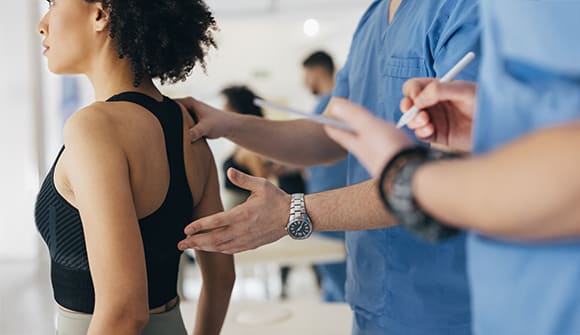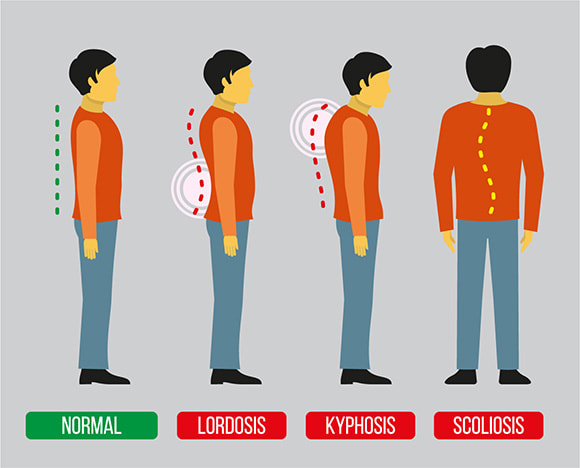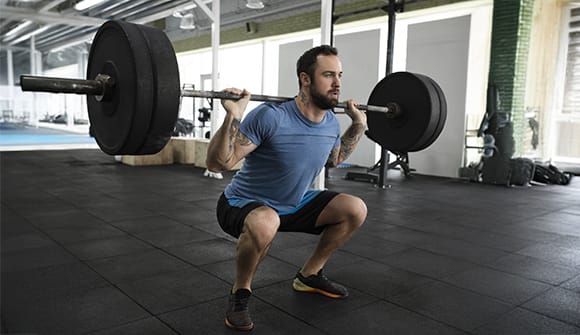Poor posture
Types of spinal curves and potential treatment options.
Article Author: Deborah Circelli
Article Date:

Stand up straight. Put your shoulders back. Fix your posture. These are common words you may have heard growing up. When you look in the mirror and check out your posture, are your shoulders hunched over too much? Is that curve in your lower back normal?
Those spinal curves may be revealing something serious.
“Maintaining good posture isn’t just about standing tall; it’s essential for spinal health,” said Sasha Vaziri, MD, a neurosurgeon with Lyerly Neurosurgery at Baptist Health. “Proper posture keeps the natural curves of your spine balanced, reducing the risk of developing spinal conditions which can lead to pain and long-term structural changes.”
Dr. Vaziri explained the three main types of spinal curves and potential treatment options for each.
1. Scoliosis
Scoliosis is a deformity in which the spine is shaped like a "C" or even an "S", instead of being straight.
Adult scoliosis can arise in two main forms:
- Degenerative scoliosis, which develops after age 40 as spinal disks and joints wear down and lose alignment.
- Progression of adolescent scoliosis, where a curve that began in the teenage years continues to worsen over time.
Dr. Vaziri said symptoms can include chronic back pain (which can be aggravated by standing or activity), nerve compression (which can cause tingling, numbness, or weakness in the legs), and postural changes such as uneven shoulders, hips, or a visible spinal curve. Some patients may also notice loss of height or a stooped appearance as the spine degenerates and the curve advances.
Scoliosis treatments: The first-line approach for adults with mild to moderate scoliosis when the spinal curve isn't worsening is non-operative treatment. This focuses on controlling pain, maintaining function and slowing the progression of the curve. Physical therapy and core strengthening play important roles and provide a tailored approach to improve posture, stabilize the spine, decrease pain, enhance flexibility and reduce muscle imbalance.
Modified yoga and Pilates can also be effective. Other non-operative strategies include anti-inflammatory medications, injections for pain relief or modifying activities.
“The cornerstone of non-surgical care remains consistent observation, structured physical therapy, and maintaining strong core musculature to protect the spine and optimize long-term function,” Dr. Vaziri said.
2. Kyphosis
Kyphosis occurs when there is excessive forward rounding of the upper back, creating a hunched or stooped posture. While a gentle curve in the upper spine is normal, too much curvature can lead to back pain, stiffness, muscle fatigue and difficulty standing fully upright or looking straight ahead. Severe cases of kyphosis can impact balance, reduce flexibility and even make breathing harder because the chest can't fully expand.
"It's just as important to avoid downward-looking habits, like checking your phone constantly, as it is to sit and stand correctly," Dr. Vaziri said. “Small daily adjustments can make a big difference in protecting your spine for years to come."
Kyphosis treatments: Posture exercises, as well as physical therapy and core strengthening, can often improve comfort and function, but severe cases may require a brace or surgery.
“If the curve continues to progress or causes significant symptoms, surgery to straighten the curve may have to be an option,” Dr. Vaziri said.
3. Lordosis
The opposite of kyphosis, lordosis is when the spine in your lower back excessively curves inward, often referred to as “swayback.”
“While it's normal to have a small inward curve, a curve that is too deep can strain the spine and surrounding muscles,” Dr. Vaziri said. “When this happens, people may experience low back pain, muscle tightness and difficulty standing or walking for long periods of time.”
Lordosis treatments: A lordotic curvature is rarely treated because it is, to some extent, normal. But if it's excessive, non-surgical treatments to relieve pain and support a healthier spinal alignment would focus on physical therapy, posture training, weight management and medication.

When to see your doctor for back pain
When a spinal curve becomes noticeable or causes discomfort, a physician can examine it and guide you through the next steps.
“Back pain is the leading reason patients seek medical attention,” Dr. Vaziri explained. “Pain may occur in the back or neck, or extend down the legs as sciatica, which can signal a nerve being compressed by a spinal deformity. While primary care providers can handle many common back problems, spinal deformities often need assessment and management by a specialist.”
Minimally invasive vs. traditional spine surgery
When it comes to surgical treatment of scoliosis, several factors come into play, including curve severity and location, the patient's age and overall health, and surgical goals. The two main approaches are minimally invasive surgery and traditional open surgery.
Dr. Vaziri said robotic-assisted and minimally invasive approaches, which focus on the most problematic portion of the spinal curve, allow for smaller incisions, robotic guidance to place screws and rods with high precision, less tissue damage, reduced blood loss, shorter hospital stays, faster recovery, and fewer complications. This approach is often used for adult scoliosis where only part of the curve is causing pain, nerve compression or functional issues.
Traditional open scoliosis surgery may be necessary for large or complex curves, progressive deformities, or in cases where multiple parts of the spine are affected.
Preventing spine curvature
Fortunately, you can protect your spine as you age.
Stretching can promote good posture and back strength. Exercises as simple as standing against a wall with your heels, buttocks, shoulders and back of the head touching it, and then extending your arms overhead while touching the wall, can promote muscle strengthening to help prevent the progression of certain spinal curves.
Baptist Health offers patients comprehensive and advanced back pain care
Offering the latest techniques, excellent quality and personalized treatment options, Baptist Health helps patients restore back function and improve quality of life. To determine if robotic spine surgery is right for you, visit baptistjax.com/back.


